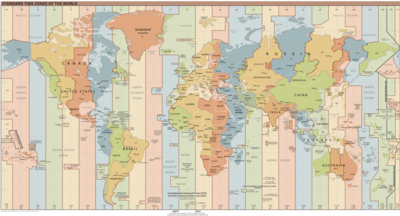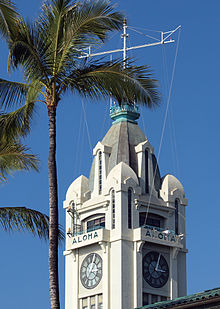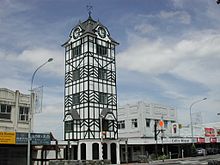
Time zones and daylight hours affect travellers in many ways. Watches and smartphones may show a time different from the local one, friends may call in the middle of the night as it is afternoon at home, and the sun may rise at wall clock times you wouldn't expect. The official local time affects opening hours, but for outdoor activities you may need to also consider when it is morning or noon according to the sun. This article discusses most of those issues. Below is also a list of countries, regions, and territories grouped by time zone. For extreme sunrise and sunset times, occurring in the far north and south, see also Midnight sun.
Understand
edit- See also: Timepieces
| “ | Like as the waves make towards the pebbled shore So do our minutes hasten to their end |
” |
—William Shakespeare, Sonnet 60 | ||
Although many time zones have descriptive names used by people in them, they are least ambiguously identified by their relationship to UTC (Universal Time, Co-ordinated). GMT (Greenwich Mean Time) is nearly synonymous, named after the Royal Observatory located in the Greenwich area of London, but its definitions have varied over time and may vary slightly by context.
UTC is also sometimes called Z or Zulu time. A time may be written as e.g. 21:45Z with the Z indicating UTC. The "Z" is for "zero", and "Zulu" is the two-way radio pronunciation of "Z". It comes from the nautical system in which each time zone was assigned a letter.
Time zones east of UTC and west of the International Date Line are specified by the number of hours ahead of UTC (e.g. UTC+4); zones west of UTC and east of the Date Line are specified by the number of hours behind UTC (e.g. UTC-6). Crossing the Date Line going eastward, clocks are turned back a full 24 hours, and vice versa in the opposite direction. The total span of time zones covers more than 24 hours because the Date Line jogs westward and eastward to keep certain national island groups on the same calendar day, although they are not within a single time zone.

While when observing "sun time", the sun is at its highest at noon, the political time zones can be stretched out or biased to differ even a few hours from this. Often the only thing that matters is wall clock time, but in areas where you'd prefer indoor activities in the hottest hours, or where daylight hours are few, check times of the hottest hours, the hours with most UV-radiation, or times of sunrise and sunset, depending on your needs. If you don't have these times available, note that the sun moves 15° of longitude by hour, so 30° east of Greenwich, the sun is at its highest at 10:00 UTC; if the time zone is UTC+1, that's 11:00. The hottest time is usually the hours after noon. Darkness comes soon after sunset near the equator, while real dusk comes half an hour after sunset at latitudes of 60°.
Sunrise and sunset can occur at vastly different times than you might be used to, varying from east to west across each time zone. As such, it might be a good idea to check sunrise and sunset times for the time of year you'll be travelling to your destination. As an example: in the American Eastern Time Zone, Boston and parts of Maine and New England, see daybreak around 4:45–5:45AM in the summer and sunset by 8PM, but in the western edge, Indiana Michigan, sunrise isn't until 6:30AM and it isn't dark til 9:15–10:15PM. Another example is Vorkuta in Russia, where sunrise and sunset annually average out at 4:40AM and 4:40PM – with "yesterday" sunrises in May and July. In western Spain, China, and Alaska, daylight averages from 8:30AM to 8:30PM.
Travel across time zones
editYou need to take some care when planning trips that cross several time zones, e.g.,
- Your "body clock" may experience some stress as you tell it to meet business appointments, tours and other obligations during hours when you'd be asleep if at home. See Jet lag.
- You may miss an important obligation, or connections with scheduled transport, simply by not understanding what will be the correct local time – or a different time used in your timetable – as you travel.
- Crossing the International Date Line can cause confusion about on what date you'll arrive:
- Starting a 12–15 hour flight from the U.S. west coast to Japan or Hong Kong in late evening can land you there in the morning two calendar days later.
- If starting the reverse course by midday, you may, in a way, travel back in time, as you land earlier than you started. For example a typical flight from Sydney to LA will take off at lunchtime and land early in the morning on the same calendar date!
- Even just crossing from one time zone to another can be confusing, as you still may arrive before you left, such as when flying from Minsk to Warsaw. You don't even need to fly, or travel east to west. The same happens when taking the north-bound bus from Utsjoki to Tana. Crossing from Kirkenes south to Murmansk Oblast (from November to March), you instead lose two hours, in addition to the travel time.
If your travel has time zone complexities or possible impacts on your health or comfort, consult an expert as you plan it.
If you're in another part of the world, family and friends should be aware of the time zone issue when contacting you. You don't want them calling you in the middle of your night, even if it for them is the time they are used to calling.
Jet lag
edit- Main article: Jet lag
Jet lag is a mismatch between your body clock and the local time wherever you are. It's caused by rapid travel across time zones, and compounded by the fact that long hours spent on a plane can cause you to sleep too much, or not enough, possibly at the wrong time. Flights from east to west, where you gain a few hours, are usually a bit easier, as most people find it easier to stay up a little later than to go to bed earlier. A rule of thumb is that you recover about 1 hour difference per day. You may find that on your way out, you are fine after just a couple of days, but you will really notice the recovery period on your way home. At that point your body clock will be really confused and it will take a while for it to sort things out.
You can aid the process a bit by trying to operate on your new local time as early as possible, and spending the daylight hours in your new time zone outdoors the first few days. If you're going to land early in the day, try to sleep on the plane so you arrive refreshed and ready for a full day of activity. Conversely, if you're going to arrive near the evening, try to stay awake on the plane so that you'll be tired when you arrive and can get a lengthy sleep.
Political time zones
editAs can be seen on the map above, some time-zones seem to defy logic and were mostly drawn by national or regional governments to make commerce and administration easier. This can have strange consequences, most notably in the case of China which "should" span five time zones but for political reasons observes the same (Beijing) time in all its territory. To complicate matters, in the restive province of Xinjiang, Beijing time is used by ethnic Han, but UTC +6 is used by ethnic Uyghurs. Departure times of long distance transport are given in one time zone (usually that of the departure point, although the Trans-Siberian railway used to run on Moscow time throughout Russia). On international waters, ship time is decided by the captain (to avoid unnecessary hassle); some Baltic ferries claim to use local time, while what they use is ship time, which corresponds to time at the departure port (with some confusion at arrival). Sir Sandford Fleming, inventor of time zones, was a railway man as rail travel was the advance that made standard time zones necessary. Some railways published schedules with disclaimers like "all times are X time" even before time zones legally existed. Stations sometimes had a clock showing railway time while the town hall or church showed a different "local time" a few minutes off – some stations in Central Europe had a row of clocks for different lines.
The time zones (and the International Date Line) often snake around political boundaries; Chicago lags a full hour behind Thunder Bay because the latter is on Ottawa's side of a provincial boundary. There's a 21-hour time difference between the Diomede Islands, a mere 3 km (1.9 mi) apart but separated by the International Date Line. Visiting the Aroostook Valley Country Club? By the time you get to the 19th hole, you may be wondering where that extra hour went... as the clubhouse was built in New Brunswick as a measure to circumvent Prohibition, putting it an hour ahead of the same course's pro shop in Maine.
Another odd time-zone border lies in Europe where (also mostly due to political reasons) going west from France lets you stay in the same time zone – when you should have to change from Central European time (UTC+1) to UTC or even UTC-1 – but going north from France to Great Britain you will have to change time-zone to GMT (UTC).
A bunch of odd time zones also exist in Australia where the central states and territories of South Australia and the Northern Territory are meant to follow UTC+9, but instead, they follow UTC+9.5 to minimise the difference and disruption when going to the eastern states. Unusually, the outback New South Welsh city of Broken Hill, is completely situated in New South Wales, 30km away from the SA border, follows ACST, and not AEST. And worst of all, there are small towns scattered across the middle of nowhere in WA close to the NT border. The problem here is, that some choose to follow AWST (UTC+8) or ACST (UTC+9.5). There's no discrete border between these time zones, and as such, you could be turning your watches back and forth by 1.5 hours frequently in these areas. And finally, in the Gold Coast-Tweed Heads (Qld-NSW), during summer, you may unexpectedly cross the border, you might have travelled an hour ahead or behind. Daylight Saving Time can further complicate matters.
A handful of time zones differ from UTC not by full hours but by (usually) some other multiple of 15 minutes. North Korea adopted UTC+8:30 briefly (which differs from South Korea's UTC+9 by half an hour) only to drop it just as abruptly during a 2018 thaw in relations; both moves were deemed political by some. Newfoundland island (UTC-3.5, summer UTC-2.5) differs from its neighbours St. Pierre and Miquelon (UTC-3 year-round), Cape Breton (UTC-4, summer UTC-3) and Blanc Sablon (UTC-4 year-round); continue into Labrador and Newfoundland time returns, only to fall back to Cape Breton's time zone somewhere between Red Bay and Cartwright.
Daylight Saving Time
editIn many jurisdictions, local time is set forward by an extra hour in summer to "shift" daylight hours to the end of the day. This is known in the UK as British Summer Time (BST, GMT+1) and almost anywhere else as Daylight Saving Time (DST) or with "Daylight Time" appended to the name of the local time zone.
Born as a wartime energy conservation measure, the adoption of DST is inherently political and its abolition (as proposed by the European Union for the near future) just as political. Most tropical countries see absolutely no need for DST, keeping standard time year round. Southern Hemisphere countries have opposite summer and winter to the Northern Hemisphere. There is no universally agreed point of the year to change from standard to daylight saving time, leaving wild leaps and fluctuations where one country has already changed and the other has not. Sometimes, one subnational jurisdiction (like Saskatchewan or Arizona) politically chooses to not use DST at all; tee off at the 9th hole of the Gateway Cities Golf Course in North Portal, Saskatchewan and the ball rolls into the cup in Portal, North Dakota an hour later. Sometimes, one country makes a political decision to start daylight saving time early during a conflict or an energy crisis; the US did this during the 1973-74 oil embargo, leaving the Thousand Islands briefly in two different time zones and disrupting TV/radio broadcast schedules. If you travel during that time or call home, inform yourself of the local time at both your destination and point of origin.
In temperate northern countries, DST usually starts late March or early April and ends late October or early November; exact start dates (and times) vary by country (but are harmonized across EU). Equatorial nations typically use no DST; southern nations will use dates that match their local summer. It's not unheard of for an individual subnational jurisdiction – or even a piece of one province – to opt out of a DST scheme in effect in the rest of the same nation. Due to the nature of daylight saving time the difference in time zones may vary during the year as one country doesn't have daylight saving time while the other does, or both have it but start at different times. However due to increasing commerce and international communication via the internet and other nearly instantaneous modes, there are increasing efforts to harmonize those things, especially among direct neighbors or political entities with good relations with each other.
Sports and time zones
editSports fans notice the impact of being in a different time zone any time they plan to view or listen to a live broadcast of a sporting event. For example, someone from the East Coast of the United States who is on the country's West Coast would watch a game three hours earlier per local time than they would while at home. By contrast, Super Bowl Sunday is actually Monday afternoon in Australia.
Global sporting organizations tend to schedule events according to when they would be viewed live in the U.S.A. and Europe. This happened with the 2020 Summer Olympics in Tokyo, when the swimming finals took place in the early morning.
List of time zones
editUTC+14
editUTC+13
editUTC+12:45
editUTC+12
edit- Fiji
- France: Wallis and Futuna
- Kiribati: Gilbert Islands
- Marshall Islands
- Nauru
- New Zealand
- Russia: MSK+9 — Anadyr, Chukotka, Kamchatka, Petropavlovsk-Kamchatsky, Yuzhno-Kurilsk
- South Pole
- Tuvalu
- Wake Island
UTC+11
edit
- Australia: Norfolk Island
- Federated States of Micronesia: Kosrae, Pohnpei
- New Caledonia
- Papua New Guinea
- Russia: MSK+8 — Chersky, Khonuu, Kuril Islands, Magadan Oblast, Srednekolymsk, Yuzhno-Sakhalinsk, Zyryanka
- Solomon Islands
- Vanuatu
- Australia: NSW, Vic, ACT and Tasmania (DST)
UTC+10:30
editUTC+10
edit- Australia: Australian Capital Territory, almost all of New South Wales, Queensland, Tasmania, Victoria (Australian Eastern Standard Time)
- Federated States of Micronesia: Chuuk, Yap
- Guam
- Northern Mariana Islands
- Papua New Guinea
- Russia: MSK+7 — Birobidzhan, Khabarovsk Krai, Vladivostok
UTC+09:30
edit- Australia: Northern Territory, South Australia, Broken Hill (New South Wales), Blackstone, Irrunytju, Warakurna, Wanarn, Kiwirrkurra, and Tjukurla (Australian Central Standard Time)
UTC+09
edit
- Indonesia (eastern): Maluku, Papua
- Japan
- Palau
- Russia: MSK+6 — Blagoveshchensk, Chita, Yakutia
- South Korea
- Timor-Leste
- North Korea
UTC+08:45
edit- Australia: Eucla, Cocklebiddy, Madura, Mundrabilla and Border Village (Also known as Australian Central Western Standard Time)
UTC+08
edit
- Australia: Western Australia (Australian Western Standard Time)
- Brunei
- China: While China should geographically be in several time zones the Central Government has declared Beijing time to be official in all of China even as far west as Tibet. While this makes travel a lot easier, it leads to sunrises at 09:00 and other strange things.
- Hong Kong
- Indonesia (central): Bali, Nusa Tenggara, Sulawesi, East and South Kalimantan
- Macau
- Malaysia
- Mongolia (most of the country)
- Philippines
- Russia: MSK+5 — Irkutsk Oblast, Ulan Ude,
- Singapore
- Taiwan
UTC+07
edit
- Cambodia
- Christmas Island (Australia)
- Indonesia (western): Java, Sumatra, West and Central Kalimantan
- Laos
- Mongolia (Hovd, Uvs, and Bayan-Ölgii)
- Russia: MSK+4 — Abakan, Barnaul, Gorno-Altaisk, Khatanga, Krasnoyarsk, Kemerovo, Kyzyl, Norilsk, Novosibirsk, Tomsk
- Thailand
- Vietnam
UTC+06:30
edit- Cocos Islands (Australia)
- Myanmar
UTC+06
editUTC+05:45
editUTC+05:30
edit
- India
- Sri Lanka
- Heard Island and McDonald Islands (Australia)
UTC+05
editUTC+04:30
editUTC+04
editUTC+03:30
editUTC+03
edit

- Bahrain
- Belarus
- Comoros
- Djibouti
- Eritrea
- Ethiopia
- Iraq
- Kenya
- Kuwait
- Madagascar
- Mayotte
- Qatar
- Russia: MSK — most of the European portion, including Moscow, Saint Petersburg, Nizhny Novgorod, Rostov-on-Don, etc. MSK traditionally had been used on all railways throughout Russia including Udmurtia
- Saudi Arabia
- Somalia
- South Sudan
- Tanzania
- Turkey
- Uganda
- Yemen
UTC+02
edit
- Botswana
- Bulgaria
- Burundi
- Democratic Republic of the Congo (eastern)
- Cyprus
- Egypt
- Estonia
- Eswatini
- Finland
- Greece
- Israel
- Jordan
- Latvia
- Lebanon
- Lesotho
- Libya
- Lithuania
- Malawi
- Moldova
- Mozambique
- Namibia
- Palestinian territories
- Romania
- Russia: MSK-1: Kaliningrad Oblast
- Rwanda
- South Africa
- Sudan
- Syria
- Ukraine
- Zambia
- Zimbabwe
UTC+01
edit

- Albania
- Algeria
- Andorra
- Angola
- Austria
- Belgium
- Benin
- Bosnia and Herzegovina
- Cameroon
- Central African Republic
- Chad
- Republic of the Congo
- Democratic Republic of the Congo (western)
- Croatia
- Czech Republic
- Denmark
- Equatorial Guinea
- France
- Gabon
- Germany
- Gibraltar
- Hungary
- Italy
- Kosovo
- Liechtenstein
- Luxembourg
- Malta
- Monaco
- Montenegro
- Morocco (year-round)
- Netherlands
- Niger
- Nigeria
- North Macedonia
- Norway
- Poland
- San Marino
- Serbia
- Slovakia
- Slovenia
- Spain
- Sweden
- Switzerland
- Tunisia
- Vatican City
UTC
edit

- Burkina Faso
- Bouvet Island
- Canary Islands
- Cote d'Ivoire
- Faroe Islands
- Gambia
- Ghana
- Greenland (northeastern)
- Guernsey
- Guinea
- Guinea-Bissau
- Iceland
- Ireland
- Isle of Man
- Jersey
- Liberia
- Mali
- Mauritania
- Northern Ireland
- Portugal
- Saint Helena, Ascension and Tristan da Cunha
- Sao Tome and Principe
- Senegal
- Sierra Leone
- Togo
- United Kingdom
- Western Sahara
UTC-01
edit- Azores (Portugal)
- Cabo Verde
- Greenland (east)
UTC-02
edit- Fernando de Noronha (Brazil)
- South Georgia and the South Sandwich Islands
- Trindade and Martim Vaz (uninhabited islands) (Brazil)
UTC-03
edit
- Argentina
- Brazil: Brasilia, Rio, São Paulo, Fortaleza, Maceio, Recife, Salvador, etc.
- Falkland Islands
- French Guiana
- Greenland (central)
- Saint Pierre and Miquelon
- Suriname
- Uruguay
UTC-03:30
edit- Canada: Newfoundland (most of Labrador, except Forteau and Red Bay, is UTC-4)
UTC-04
edit
- Anguilla
- Antigua and Barbuda
- Aruba
- Barbados
- Bermuda
- Bolivia
- Bonaire
- Brazil: Boa Vista, Campo Grande, Manaus
- British Virgin Islands
- Canada (Atlantic Standard Time): New Brunswick, Nova Scotia, Prince Edward Island, most of Labrador, a small portion of eastern Quebec. Québec does not use Atlantic Daylight Time.
- Chile
- Curaçao
- Dominica
- Dominican Republic
- Greenland (west)
- Grenada
- Guadeloupe
- Guyana
- Martinique
- Montserrat
- Paraguay
- Puerto Rico
- Saba
- Saint-Barthelemy
- Saint Kitts and Nevis
- Saint Lucia
- Saint Martin
- Saint Vincent and the Grenadines
- Sint Eustatius
- Sint Maarten
- Trinidad and Tobago
- Turks and Caicos Islands
- U.S. Virgin Islands
- Venezuela
UTC-05
edit
- Bahamas
- Brazil: Acre
- Canada (Eastern Standard Time): Nunavut, most of Ontario, most of Quebec. This zone runs from Anticosti (63°W) past Thunder Bay (so westward to 90°W), to include most of Canada's population and the entire beaten-path Windsor-Quebec corridor.
- Cayman Islands
- Colombia
- Cuba
- Ecuador
- Haiti
- Jamaica
- Mexico: Quintana Roo
- Panama
- Peru
- United States of America (Eastern Standard Time): Maine, New Hampshire, Vermont, Massachusetts, Connecticut, Rhode Island, New York, Michigan except extreme northwestern counties, Indiana except the southwest and northwest corners, Ohio, Pennsylvania, New Jersey, eastern Kentucky, West Virginia, Virginia, Washington, D.C., Maryland, Delaware, eastern Tennessee, North Carolina, Georgia, South Carolina, Florida except western part of panhandle.
UTC-06
edit
- Belize
- Canada (Central Standard Time): Manitoba, Saskatchewan except for the region around Lloydminster, part of north-western Ontario. Saskatchewan does not use daylight time, except in Lloydminster.
- Chile: Easter Island
- Costa Rica
- Ecuador: Galapagos Islands
- El Salvador
- Guatemala
- Honduras
- Mexico
- Nicaragua
- United States of America (Central Standard Time): Wisconsin, Illinois, the southwest and northwest corners of Indiana, western Kentucky, western and middle Tennessee, Mississippi, Alabama, Minnesota, Iowa, Missouri, Arkansas, Louisiana, north and east North Dakota, eastern South Dakota, middle and eastern Nebraska, most of Kansas, Oklahoma, most of Texas, part of western Florida(panhandle).
UTC-07
edit- Canada (Mountain Standard Time): Alberta, small eastern portion of British Columbia, both sides of Lloydminster, which lies on the Alberta–Saskatchewan border
- Mexico: Baja California Sur: Chihuahua, Nayarit, Sinaloa, Sonora. No Daylight Time in Sonora.
- United States of America (Mountain Standard Time): southwest North Dakota, western South Dakota, western Nebraska, a sliver of Kansas, Montana, a sliver of Oregon, southern Idaho, Wyoming, Utah, Colorado, Arizona, New Mexico, a corner of Texas. No Daylight Time in Arizona, except for the Navajo Nation.
UTC-08
edit
- Canada (Pacific Standard Time): most of British Columbia, Yukon
- Clipperton Island
- Mexico: Baja California Norte
- Pitcairn Islands
- United States of America (Pacific Standard Time): Washington, northern Idaho, most of Oregon, California, Nevada
UTC-09
editUTC-09:30
editUTC-10
edit
- Cook Islands
- French Polynesia (France): Society Islands, Tuamotu Islands, Austral Islands
- Johnston Atoll (US)
- United States of America: Hawaii, and Aleutian Islands in Alaska

